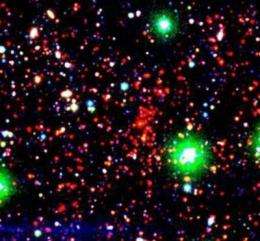Largest ever survey of very distant galaxy clusters completed

An international team of researchers led by a UC Riverside astronomer has completed the largest ever survey designed to find very distant clusters of galaxies.
Named the Spitzer Adaptation of the Red-sequence Cluster Survey, "SpARCS" detects galaxy clusters using deep ground-based optical observations from the CTIO 4m and CFHT 3.6m telescopes, combined with Spitzer Space Telescope infrared observations.
In a universe which astronomers believe to be 13.7 billion years old, SpARCS is designed to find clusters, snapped as they appeared long ago in time, when the universe was 6 billion years old or younger.
Clusters of galaxies are rare regions of the universe consisting of hundreds of galaxies containing trillions of stars, plus hot gas and mysterious dark matter. Most of the mass in clusters is actually in the form of invisible dark matter which astronomers are convinced exists because of its influence on the orbits of the visible galaxies.
An example of one of the most massive clusters found in the SpARCS survey is shown in the accompanying image. Seen when the universe was a mere 4.8 billion years old, this is also one of the most distant clusters ever discovered. Many similar-color red cluster galaxies can be seen in the image (the green blobs are stars in our own galaxy, The Milky Way).
"We are looking at massive structures very early in the universe's history," said Gillian Wilson, an associate professor of physics and astronomy who leads the SpARCS project.
The SpARCS survey has discovered about 200 new cluster candidates.
"It is very exciting to have discovered such a large sample of these rare objects," Wilson said. "Although we are catching these clusters at early times, we can tell by their red colors that many of the galaxies we are seeing are already quite old. We will be following up this new sample for years to come, to better understand how clusters and their galaxies form and evolve in the early universe."
More information: A summary of the survey and additional images of newly discovered clusters may be found in two companion papers led by Wilson and Adam Muzzin of Yale University, published in the June 20 issue of The Astrophysical Journal.
Source: University of California - Riverside (news : web)


















